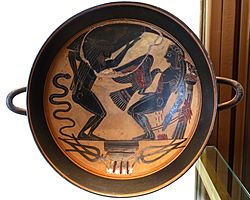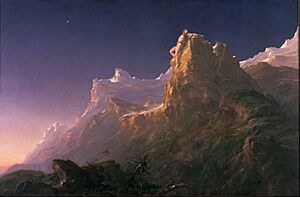Prometheus facts for kids
Quick facts for kids Prometheus |
|
|---|---|
| God of forethought and crafty counsel, culture hero, and trickster figure in Greek mythology | |
 |
|
| Abode | Mount Olympus |
| Personal information | |
| Children | Deucalion |
| Parents | Iapetus and Asia or Clymene |
| Siblings | Atlas, Epimetheus, Menoetius, Anchiale |
In Greek mythology, Prometheus was a powerful Titan god. His name, Prometheus, likely means "forethought" or "planning ahead". He is famous for bravely stealing fire from the gods. He then gave this precious gift to humans. Fire in this story often represents technology, knowledge, and the start of civilization.
Zeus, the powerful king of the Olympian gods, was very angry. He decided to punish Prometheus severely for helping humans. Prometheus was chained to a rock, and a giant eagle would come every day. The eagle would eat his liver, which would then grow back overnight. This painful torment was meant to last forever. However, the great hero Heracles eventually freed Prometheus.
Prometheus's Story and Origins
The oldest stories about Prometheus come from an ancient Greek poet named Hesiod. He wrote about Prometheus in the late 700s BC. In these tales, Prometheus was a son of the Titan Iapetus. His mother was either Clymene or Asia. He had three brothers: Menoetius, Atlas, and Epimetheus. His brother Epimetheus's name means "afterthought," which is the opposite of Prometheus's name.
Stories about a clever character stealing fire are found in many cultures worldwide. Some parts of Prometheus's story are similar to the Sumerian myth of Enki. Enki was also a god who helped humans and protected them from other gods. He even created humans from clay, just like Prometheus is sometimes said to have done.
Worship and Festivals
In ancient Greece, people did not widely worship Prometheus. He was mainly honored in the city of Athens. There, he was worshipped alongside the goddess Athena and the god Hephaestus.
Athens had an altar dedicated to Prometheus in a special grove called the Academy. During the Panathenaic festival, a torch race would start at this altar. Runners would carry torches through the city. The race ended at the Acropolis, where the torch was used to light a special fire for Athena. This torch relay was called lampadedromia and honored Prometheus.
By the Classical period, Athens held a festival called the Prometheia. During this festival, people wore wreaths. These wreaths were a symbol of the chains that bound Prometheus. Other places in Greece also honored Prometheus. Both Argos and Opous claimed to be his final resting place. The city of Panopeus even had a statue honoring Prometheus for creating humans there.
Prometheus in Art and Music
Prometheus's story has inspired many artists and writers throughout history. His punishment by the eagle and his rescue by Heracles were popular scenes. You can see them on ancient Greek vase paintings from the 6th to 4th centuries BC.
Many ancient Greek and Roman writers wrote plays and philosophical works about Prometheus. His story continued to be told and changed over time. Later, in the Middle Ages, the Renaissance, and modern times, Prometheus appeared in many famous artworks.
His myth has also inspired many pieces of classical music, opera, and ballet. For example, Franz Liszt composed a symphonic poem called Prometheus in 1850. Alexander Scriabin wrote Prometheus: Poem of Fire in 1910. Even Beethoven composed music for a ballet about the myth called The Creatures of Prometheus in 1801.
Interesting Facts About Prometheus
- In some myths, Prometheus is believed to have created humanity from clay.
- He is known for being very smart and a great supporter of humankind.
- Many people see him as the one who taught humans arts and sciences.
- The ancient Greeks thought the rock where Prometheus was chained was Mount Elbrus or Mount Kazbek. These mountains are in the Caucasus Mountains.
- In Western culture, Prometheus has become a symbol. He represents humanity's search for scientific knowledge. He also shows the dangers of trying to do too much.
- Mary Shelley gave her famous novel Frankenstein (1818) the subtitle The Modern Prometheus.
- The artificial chemical element promethium is named after him.
Prometheus's Family Tree
| Prometheus's family tree | |||||||||||||||||||||||||||||||||||||||||||||||||||||||||||||||||||||||||||||||||||||||||||||||||||||||||||||||||||||||||||||||||||||||||||||||||||||||||||||||||||||||||||||||||||||||||||||||||||||||||||||||||||||||||||||||||||||||||||||||||||||||||||||||||||||||||||||||||||||||||||||||||||||||||||||||||||||||||||||||||||||||||||||||||||||||||||||||||||||||||||||||||||||||||||||||||||||||||||||||||||||||||||||||||||||||||||||||||||||||||||||||||||||||||||||||||||||||||||||||||||||||||||||||||||||||||||||||||||||||||||||||||||||||||||||||||||||||||||||||||||||||||||||||||||||||||||||||||||||||||||||||||||||||||||||||||||||||||||||||||||||||||||||||||||||||||||||||||||||||||||||||||||||||||||||||||||||||||||||||||||||||||||||||||||||||||||||||||||||||||||||||||||||||||||||||||||||||||||||||||||||||||||||||||||||||||||||||||||||||||||||||||||||||||||||||||||||||||||||||||||||||||||||||||||||||||||||||||||||||||||||||||||||||||||||||||||||||||||||||||||||||||||||||||||||||||||||||||||||||
|---|---|---|---|---|---|---|---|---|---|---|---|---|---|---|---|---|---|---|---|---|---|---|---|---|---|---|---|---|---|---|---|---|---|---|---|---|---|---|---|---|---|---|---|---|---|---|---|---|---|---|---|---|---|---|---|---|---|---|---|---|---|---|---|---|---|---|---|---|---|---|---|---|---|---|---|---|---|---|---|---|---|---|---|---|---|---|---|---|---|---|---|---|---|---|---|---|---|---|---|---|---|---|---|---|---|---|---|---|---|---|---|---|---|---|---|---|---|---|---|---|---|---|---|---|---|---|---|---|---|---|---|---|---|---|---|---|---|---|---|---|---|---|---|---|---|---|---|---|---|---|---|---|---|---|---|---|---|---|---|---|---|---|---|---|---|---|---|---|---|---|---|---|---|---|---|---|---|---|---|---|---|---|---|---|---|---|---|---|---|---|---|---|---|---|---|---|---|---|---|---|---|---|---|---|---|---|---|---|---|---|---|---|---|---|---|---|---|---|---|---|---|---|---|---|---|---|---|---|---|---|---|---|---|---|---|---|---|---|---|---|---|---|---|---|---|---|---|---|---|---|---|---|---|---|---|---|---|---|---|---|---|---|---|---|---|---|---|---|---|---|---|---|---|---|---|---|---|---|---|---|---|---|---|---|---|---|---|---|---|---|---|---|---|---|---|---|---|---|---|---|---|---|---|---|---|---|---|---|---|---|---|---|---|---|---|---|---|---|---|---|---|---|---|---|---|---|---|---|---|---|---|---|---|---|---|---|---|---|---|---|---|---|---|---|---|---|---|---|---|---|---|---|---|---|---|---|---|---|---|---|---|---|---|---|---|---|---|---|---|---|---|---|---|---|---|---|---|---|---|---|---|---|---|---|---|---|---|---|---|---|---|---|---|---|---|---|---|---|---|---|---|---|---|---|---|---|---|---|---|---|---|---|---|---|---|---|---|---|---|---|---|---|---|---|---|---|---|---|---|---|---|---|---|---|---|---|---|---|---|---|---|---|---|---|---|---|---|---|---|---|---|---|---|---|---|---|---|---|---|---|---|---|---|---|---|---|---|---|---|---|---|---|---|---|---|---|---|---|---|---|---|---|---|---|---|---|---|---|---|---|---|---|---|---|---|---|---|---|---|---|---|---|---|---|---|---|---|---|---|---|---|---|---|---|---|---|---|---|---|---|---|---|---|---|---|---|---|---|---|---|---|---|---|---|---|---|---|---|---|---|---|---|---|---|---|---|---|---|---|---|---|---|---|---|---|---|---|---|---|---|---|---|---|---|---|---|---|---|---|---|---|---|---|---|---|---|---|---|---|---|---|---|---|---|---|---|---|---|---|---|---|---|---|---|---|---|---|---|---|---|---|---|---|---|---|---|---|---|---|---|---|---|---|---|---|---|---|---|---|---|---|---|---|---|---|---|---|---|---|---|---|---|---|---|---|---|---|---|---|---|---|---|---|---|---|---|---|---|---|---|---|---|---|---|---|---|---|---|---|---|---|---|---|---|---|---|---|---|---|---|---|---|---|---|---|---|---|---|---|---|---|---|---|---|---|---|---|---|---|---|---|---|---|---|---|---|---|---|---|---|---|---|---|---|---|---|---|---|---|---|---|---|---|---|---|---|---|---|---|---|---|---|---|---|---|---|---|---|---|---|---|---|---|---|---|---|---|---|---|---|---|---|---|---|---|---|---|---|---|---|---|---|---|---|---|---|---|---|---|---|---|---|---|---|---|---|---|---|---|---|---|---|---|---|---|---|---|---|---|---|---|---|---|---|---|---|---|---|---|---|---|---|---|---|---|---|---|---|---|---|---|---|---|---|---|---|---|---|---|---|---|---|---|---|---|---|---|---|---|---|---|---|---|---|---|---|---|---|---|---|---|---|---|---|---|---|---|---|---|---|---|---|---|---|---|---|---|---|---|---|---|---|---|---|---|---|---|---|---|---|---|---|---|---|---|---|---|---|---|---|---|---|---|---|---|---|---|---|---|---|---|---|---|---|---|---|---|---|---|---|---|---|---|---|---|---|---|---|---|---|---|---|---|---|---|---|---|---|---|---|---|---|---|---|---|---|---|---|---|---|---|---|---|---|---|---|---|---|---|---|---|---|---|---|---|---|---|---|---|---|---|---|---|---|---|---|---|---|---|---|---|---|---|---|---|---|---|---|---|---|---|---|---|---|---|---|---|---|---|---|---|---|---|---|---|---|---|---|---|---|---|---|---|---|---|---|---|---|---|---|---|---|---|---|---|---|---|---|---|
|
|||||||||||||||||||||||||||||||||||||||||||||||||||||||||||||||||||||||||||||||||||||||||||||||||||||||||||||||||||||||||||||||||||||||||||||||||||||||||||||||||||||||||||||||||||||||||||||||||||||||||||||||||||||||||||||||||||||||||||||||||||||||||||||||||||||||||||||||||||||||||||||||||||||||||||||||||||||||||||||||||||||||||||||||||||||||||||||||||||||||||||||||||||||||||||||||||||||||||||||||||||||||||||||||||||||||||||||||||||||||||||||||||||||||||||||||||||||||||||||||||||||||||||||||||||||||||||||||||||||||||||||||||||||||||||||||||||||||||||||||||||||||||||||||||||||||||||||||||||||||||||||||||||||||||||||||||||||||||||||||||||||||||||||||||||||||||||||||||||||||||||||||||||||||||||||||||||||||||||||||||||||||||||||||||||||||||||||||||||||||||||||||||||||||||||||||||||||||||||||||||||||||||||||||||||||||||||||||||||||||||||||||||||||||||||||||||||||||||||||||||||||||||||||||||||||||||||||||||||||||||||||||||||||||||||||||||||||||||||||||||||||||||||||||||||||||||||||||||||||||
Images for kids
-
Prometheus in a sculpture by Nicolas-Sébastien Adam, 1762 (Louvre)
See also
 In Spanish: Prometeo para niños
In Spanish: Prometeo para niños
- Prometheism
- Tityos, another giant punished by vultures eating his liver.
- Hubris, meaning extreme pride or overconfidence.




